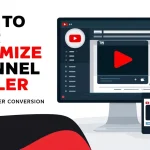How to Create a Content Calendar for Consistent YouTube Uploads
Consistency is the secret weapon for YouTube success. Regular uploads keep your audience engaged and make the algorithm work in your favor. But how do you stay consistent without burning out or running out of ideas? The answer lies in creating a well-organized YouTube content calendar.
In this guide, we’ll explore the steps, tools, and tips to build and maintain a content calendar that ensures consistent uploads and sustained growth.
Why Consistency Matters on YouTube
1. The Algorithm Loves Consistency
YouTube's algorithm favors creators who upload regularly. Consistent uploads increase your chances of appearing in search results and being recommended to new viewers. If the algorithm detects your reliability, your content gets more visibility.
2. Building Audience Trust
When your audience knows when to expect your content, they’re more likely to tune in. This builds trust and loyalty, turning casual viewers into dedicated subscribers. Consistency is key to creating a habit for your viewers.
Benefits of a YouTube Content Calendar
1. Improved Planning and Organization
A content calendar helps you stay ahead by planning videos weeks or months in advance. No more scrambling for ideas or rushing to meet deadlines—it’s all laid out.
2. Ensuring Content Variety
With a calendar, you can strike the perfect balance between different types of videos. For example, tutorials, vlogs, challenges, and product reviews can be scheduled in a way that keeps your audience interested.
3. Better Collaboration and Efficiency
If you work with a team or collaborators, a content calendar ensures everyone is aligned. Editors, designers, and partners know what to expect and when to deliver.
Steps to Create a YouTube Content Calendar
1. Define Your Goals and Themes
Start with your goals. Are you looking to grow subscribers, increase engagement, or build brand awareness? Next, identify the key themes or content pillars for your channel. For example:
- Tech channel: Product reviews, tutorials, and tech news.
- Cooking channel: Recipes, cooking hacks, and food challenges.
2. Choose the Right Tools
Your tools should match your needs and budget. Some popular options include:
- Google Sheets or Excel: Simple and free for tracking schedules.
- Trello or Notion: Ideal for visualizing workflows.
- Airtable: A robust tool for managing large-scale content calendars.
3. Map Out Your Upload Schedule
Decide on your upload frequency—weekly, bi-weekly, or even daily. Use
YouTube Analytics to find the best days and times to post based on when your audience is most active.
4. Brainstorm and Organize Ideas
Create a “content bank” where you jot down all your video ideas. Tools like
Google Trends,
AnswerThePublic, and
TubeBuddy can help you discover trending topics relevant to your niche.
5. Assign Deadlines and Break Down Tasks
Divide the video creation process into smaller steps:
- Research and scripting.
- Filming and editing.
- Thumbnail creation and video optimization.
Assign deadlines for each step to avoid last-minute stress.
6. Plan for Flexibility
Life happens, and trends change quickly. Build buffer time into your calendar and maintain a library of pre-filmed or evergreen content to fill gaps when needed.
Tips for Maintaining Consistency
1. Batch Production
Save time by batching tasks. For example, film multiple videos in one session or edit several videos back-to-back. This reduces the overall time spent on each video.
2. Monitor and Adjust
Track the performance of your videos using
YouTube Analytics. Adjust your strategy based on viewer engagement, click-through rates, and watch time.
3. Stay Ahead of Trends
Keep an eye on seasonal trends and upcoming holidays. Plan your content around these opportunities to attract timely traffic.
4. Avoid Burnout
Consistency doesn’t mean overworking yourself. Set realistic goals, take breaks, and outsource tasks like editing or thumbnail design if needed.
Sample Content Calendar Template
Here’s an example of how you can structure your weekly and monthly content calendar:
Weekly Example
- Monday: Research topics and outline scripts.
- Tuesday: Film videos.
- Wednesday: Edit videos and design thumbnails.
- Thursday: Schedule videos and write descriptions.
- Friday: Promote videos on social media.
- Weekend: Audience engagement and brainstorming.
Monthly Overview
- Week 1: Trending topic video.
- Week 2: Tutorial or how-to video.
- Week 3: Collaboration or challenge video.
- Week 4: Q&A or community-focused video.
FAQs: How to Create a Content Calendar for Consistent YouTube Uploads
Why is a YouTube content calendar important?
A content calendar helps you plan, organize, and schedule your videos in advance. It ensures consistency, improves productivity, and allows you to maintain a steady upload schedule—key factors for growing your channel and engaging your audience.
What tools can I use to create a YouTube content calendar?
There are several tools you can use, depending on your needs:
- Free tools: Google Sheets, Excel, and Trello.
- Paid tools: Airtable, Notion, and Asana.
These tools let you organize ideas, set deadlines, and collaborate with others efficiently.
How often should I upload videos to stay consistent?
The ideal upload frequency depends on your content type and capacity. Many creators find success with weekly uploads, but the key is to pick a schedule you can realistically maintain. Use
YouTube Analytics to determine when your audience is most active and post accordingly.
How can I ensure my content calendar stays flexible?
Plan for flexibility by:
- Leaving buffer time between major tasks.
- Creating a backlog of evergreen content to use when unexpected delays occur.
- Staying updated on trends and making room to incorporate timely topics into your schedule.
What should I include in my content calendar?
A YouTube content calendar should include:
- Video ideas or themes.
- Upload dates and times.
- Deadlines for each stage of production (scripting, filming, editing, etc.).
- Notes on promotion strategies (e.g., social media posts).
- Analytics for tracking the performance of past videos.
Conclusion
A YouTube content calendar is more than just a schedule—it’s a roadmap to consistency and growth. By planning ahead, staying organized, and being flexible, you can maintain a steady flow of high-quality content that keeps your audience coming back for more.
Start small, track your progress, and refine your strategy as you grow. With a well-planned calendar, consistency will become second nature, and success will follow.
Last Updated: January 16, 2025























Comment (0)
No comments available.